|
 Printer Printer
 Presets Presets
 Copies & Pages Copies & Pages
 Layout Layout
 Output Options Output Options
 Scheduler Scheduler
 Paper Handling Paper Handling
 ColorSync ColorSync
 Cover Page Cover Page
 Print Settings Print Settings
 Printer Color Management Printer Color Management
 Paper Configuration Paper Configuration
 Expansion Expansion
 Summary Summary
 Saving your settings in the Print dialog Saving your settings in the Print dialog
 Using your saved settings in the Print dialog Using your saved settings in the Print dialog
 Preview Preview
You can make the appropriate Printer and Presets settings use for printing.
 |
Note: |
 |
|
The Print dialog is the standard feature of Mac OS X. See your operating system’s documentation for details.
|
|
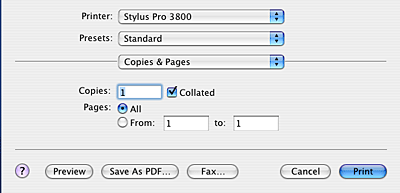
Select a printer you want to use.
 |
Note: |
 |
|
Always match the Format for setting in the Page Setup dialog with the Printer setting in the Print dialog; otherwise, data may not be printed correctly.
|
|
You can select Standard or Save As.
Prints with the current settings.
Prints with the custom saved settings.
You can make the appropriate Copies, Collated, Pages settings that you want to use for printing.

To make the Copies setting, enter the number of copies that you want to print in the Copies text box.
To make print order setting, select Collated to print one complete document set at a time when printing multiple copies.
To make the Pages setting, select either All or From and to. If you select From and to, enter the first page of the appropriate range of pages in the From text box and the last page in the to text box.
You can make the appropriate Pages per Sheet, Layout Direction, and Border settings that you want to use for printing.

 |
Note: |
 |
|
Layout is the standard feature of Mac OS X. See your operating system’s documentation for details.
|
|
You can print multiple pages of your data on a single piece of paper. You can select from 1, 2, 4, 6, 9, or 16.
You can specify the order in which the pages will be printed on the sheet of paper.
You can print a border around the pages printed on each sheet. You can select from None, Single hairline, Single thin line, Double hairline, or Double thin line.
You can print your data as a file if you click the Save as File check box, and select its format from the Format pull-down menu.
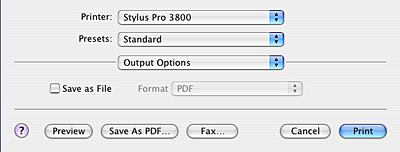
If you want to print your data on paper, clear the Save as File check box.
 |
Note: |
 |
|
Output Options is the standard feature of Mac OS X. See your operating system’s documentation for details.
|
|
You can make the appropriate Print Document (time) and Priority settings that you want to use for printing.
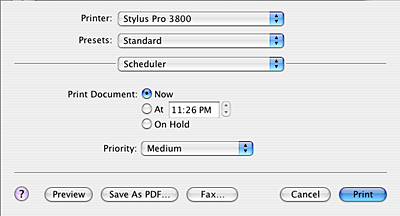
 |
Note: |
 |
|
Scheduler is the standard feature of Mac OS X. See your operating system’s documentation for details.
|
|
You can make the appropriate Page Order, Print (pages), and Destination Paper Size settings that you want to use for printing.
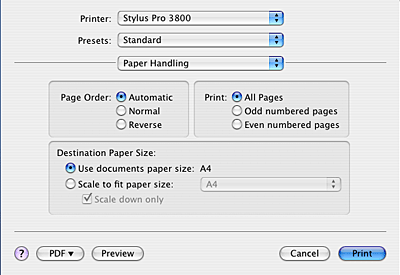
 |
Note: |
 |
|
Paper Handling is the standard feature of Mac OS X. See your operating system’s documentation for details.
|
|
You can make the appropriate Color Conversion and Quartz Filter settings that you want to use for printing.
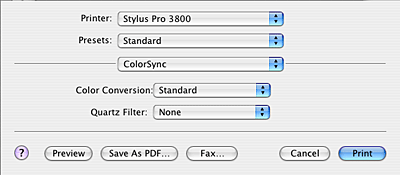
 |
Note: |
 |
|
ColorSync is the standard feature of Mac OS X. See your operating system’s documentation for details.
|
|
You can make the appropriate Print Cover Page, Cover Page Type, and Billing Info settings that you want to use for printing.
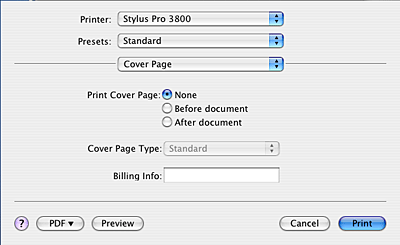
 |
Note: |
 |
|
Cover Page is the standard feature of Mac OS X. See your operating system’s documentation for details.
|
|
You can make the Page Setup, Media Type, Color, and Mode settings.
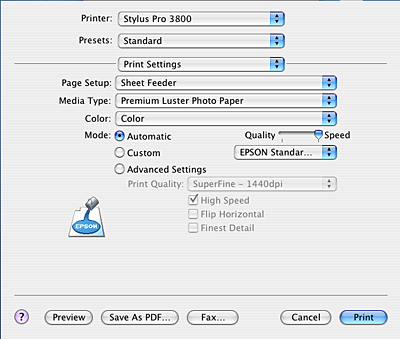
Shows the print area that has been chosen from the Paper Size list in the Page Setup dialog. Select the print area chosen from the Paper Size list in the Page Setup dialog.
If you have selected custom paper, the paper source pull-down menu appears. Select Sheet Feeder if you are using the Auto Sheet Feeder. Select Manual-Front or Manual-Rear if you are using the front or rear manual feed slot.
The Media Type setting determines what other settings are available; therefore, always make this setting first.
From Media Type, select a media that matches the paper loaded in the printer. Find your paper in the list, and then select a corresponding Media Type setting. For some kinds of paper, several Media Type settings are available for selection.
 |
Note: |
|
Media Type Setting
|
Epson Special Media Name/Description
|
|
Premium Luster Photo Paper
|
Premium Luster Photo Paper
|
|
Premium Glossy Photo Paper
|
Premium Glossy Photo Paper
|
|
Premium Semigloss Photo Paper
|
Premium Semigloss Photo Paper
|
|
Proofing Paper Semimatte
|
EPSON Proofing Paper Semimatte (Commercial)
|
|
Plain Paper - Photo Black
|
-
|
|
Enhanced Matte Paper
|
Enhanced Matte Paper
|
|
Archival Matte Paper
|
Archival Matte Paper
|
|
Velvet Fine Art Paper
|
Velvet Fine Art Paper
|
|
UltraSmooth Fine Art Paper
|
UltraSmooth Fine Art Paper
|
|
Watercolor Paper - Radiant White
|
Watercolor Paper - Radiant White
|
|
Photo Quality Ink Jet Paper
|
Photo Quality Ink Jet Paper
|
|
Singleweight Matte Paper
|
Singleweight Matte Paper
|
|
Plain Paper - Matte Black
|
-
|
|
Singleweight Matte Paper (line drawing)
|
Singleweight Matte Paper
|
Make the Color setting. Select Color to print color or monochrome photos, or Black to print a draft or black text only. If you want to print advanced monochrome photos, select Advanced B&W Photo.
 |
Note: |
 |
|
When printing on any media, we recommend Color even if the data to print is black.
|
|
You can select the Automatic, Custom, or Advanced Settings.
Automatic is the quickest and easiest way to start printing. When Automatic is selected, the printer driver takes care of all detailed settings based on the current Media Type and Color settings.

Depending on the media you choose in the Media Type setting while Color or Black is selected as the Color setting and Automatic as the Mode setting, a Quality or Speed slider appears in the Mode box. Select Quality when print quality is more important than print speed. Select Speed when print speed is more important than print quality.
When Color is selected as the Color setting and Automatic as the Mode setting, the Color Control pull-down menu appears.
You can select from the following settings.
|
EPSON Vivid
|
Select this setting to produce vivid blue and green tones in printouts.
Note:
Because this setting reproduces blue and green tones that cannot be displayed by your monitor, your printouts may differ from the screen images when this function is selected.
|
|
Charts and Graphs
|
Intensifies the colors and lightens the midtones and highlights of an image. Use this setting for presentation graphics, such as charts and graphs.
|
|
EPSON Standard (sRGB)
|
Increases the contrast in images. Use this setting for color photographs.
|
|
Adobe RGB
|
Matches image color to Adobe RGB.
|
Custom lets you make a wide range of changes with a single click of the mouse. In the Custom Settings pull-down menu, you will find ready-made settings provided by Epson.
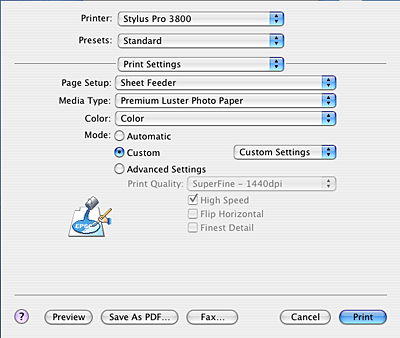
The Custom Settings pull-down menu includes the following ready-made settings.
 |
Note: |
 |
|
These ready-made settings may be dimmed, depending on the Media Type and Color settings.
|
|
|
Advanced Photo 2880
|
Good for printing scanned photos and digitally captured images in high quality. Helps prevent misprinting of ink dots that may occur due to movement of the print heads and paper.
|
|
ColorSync
|
Automatically adjusts printout colors to match colors on your screen.
|
Advanced Setting gives you complete control over your printing environment. Use these settings to experiment with new printing ideas, or to fine-tune a range of print settings to meet your individual needs. Once you are satisfied with your new settings, you can give them a name and add them to the Custom Settings list.
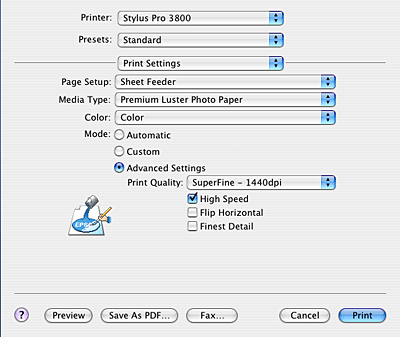
|
Print Quality
|
Select the print quality that you want to use for printing.
|
|
High Speed
|
Activates bidirectional printing so your printer prints in both left-to-right and right-to-left directions. This setting speeds up printing, but decreases the print quality.
|
|
Flip Horizontal
|
Prints your data as it would appear in a mirror. Text and graphics appear reversed.
|
|
Finest Detail
|
Depending on the Print Quality setting you select, you can turn on Finest Detail to print text, solid graphics, and line art with very sharp edges.
|
|
Color Toning
|
When you select Advanced B&W Photo as the Color, the Color Toning pull-down menu appears.
Neutral:
This setting provides standard image correction for most photos. Try this first.
Cool:
This setting gives a cool tone to your photos.
Warm:
This setting gives a warm tone to your photos.
Sepia:
This setting applies a sepia tone to your photos.
Fine Adjustment:
This setting appears when you change the Tone, adjust the settings using the slide bars or the color circle, or select the Highlight Point Shift check box.
|
This option gives you control over the color matching and adjustment methods provided by the printer driver.
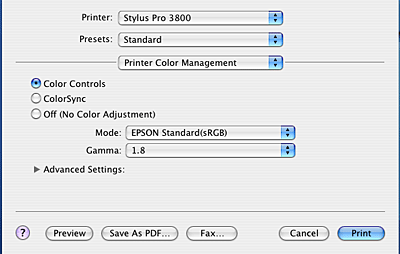
Use these settings to experiment with new printing ideas or to fine-tune a range of printer settings to meet your individual needs. Once you are satisfied with your new settings, you can add them to the Custom Setting list in the Print dialog.
Select this setting to use the color matching and adjustment methods provided with the printer. Click the triangle next to the Advanced Settings to see details.
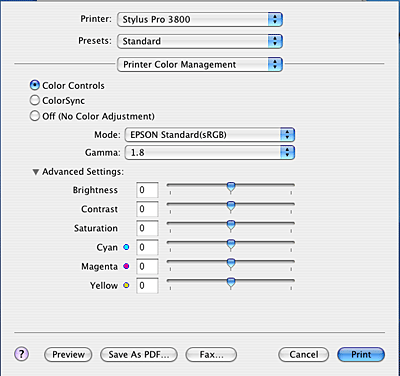
|
EPSON Vivid
|
Select this setting to enrich the blue and green tones in printouts.
Note:
Because this setting reproduces blue and green tones that cannot be displayed by your monitor, your printouts may differ from the screen images when this function is selected.
|
|
Charts and Graphs
|
Intensifies the colors and lightens the midtones and highlights of an image. Use this setting for presentation graphics, such as charts and graphs.
|
|
EPSON Standard (sRGB)
|
Increases the contrast in images. Use this setting for color photographs.
|
|
Adobe RGB
|
Matches image color to Adobe RGB.
|
Controls image contrast by modifying the midtones and mid-level grays.
The color enhancement sliders adjust the indicated options in a range of -25% to +25%.
Drag the slider to the right or left with your mouse to adjust the settings. You can also type a value from -25% to +25% in the boxes next to the sliders.
Color Controls (for Advanced B&W Photo)
When Advanced B&W Photo is selected as the Color, the following screen appears. You can adjust the advanced monochrome settings. For the details of additional settings, see the online help.
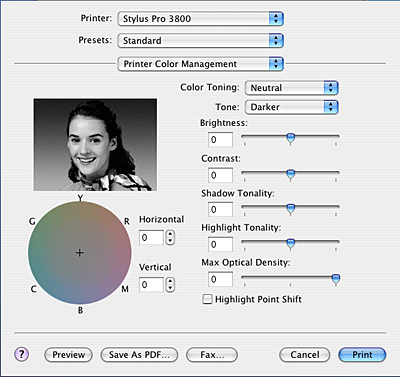
This setting automatically adjusts printout colors to match colors on your screen. Select this setting when printing scanned photographs or computer graphics. See Color Management for detailed information on color management.
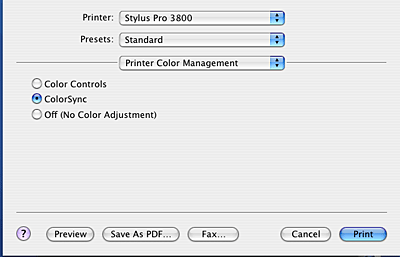
 |
Note: |
 |
|
Be aware that the ambient light and the age, quality, and settings of the monitor can affect the quality of your color matching.
|
|
Off (No Color Adjustment)
This setting is generally not recommended, because it does not allow the printer driver to enhance or adjust the color in any way. Only use this setting when you create a new color profile or if the other Mode settings do not produce satisfactory results. See Color Management for detailed information on color management.
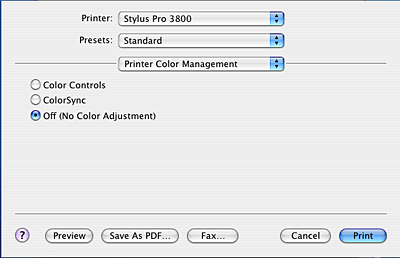
The following settings in Paper Configuration let you make the detailed paper settings. If you are using non-Epson special media, make these settings as needed.
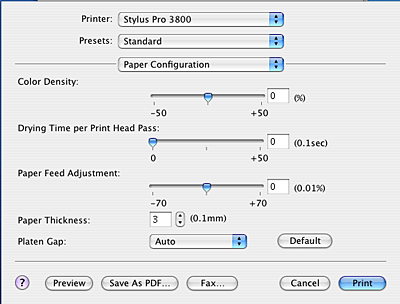
|
Mode
|
Description
|
|
Color Density
|
Adjusts the strength of Color Density. Use a value in the range of -50% to +50%. Drag the slider with your mouse to the right direction (+) to deepen the color of your printout or left direction (-) to lighten its color. You can also type a number (-50 to +50) in the box next to the slider.
Use this function when you print on paper other than Epson special media.
Set the scroll bar to the 0 position when you print on Epson special media.
Note:
Deepening of the color of printout may not be possible, depending on the printing mode.
|
|
Drying Time per Print Head Pass
|
Adds a waiting time when the print head reaches the end of every pass.
Set this value using the slider or text box. To improve the print quality by using slow ink absorption on the media, set a higher value.
The drying time per print head pass can be set from 0 to 5 seconds, in 0.1 second increments.
Note:
If you use this feature, the printing time will be longer.
|
|
Paper Feed Adjustment
|
Controls the paper feeding value, in 0.01% increments. If the paper feeding value is too large, white horizontal micro banding may appear. If the paper feeding value is too small, dark horizontal micro banding may appear.
|
|
Paper Thickness
|
This value automatically appears according to the media for the Media Type setting. If you use non-Epson media, modify this value for your media is recommended. Refer to the paper specifications, or print "Thickness Pattern" to find out the paper thickness.
|
|
Platen Gap
|
Platen Gap is the height from the media loaded in the printer to the print head. By adjusting this parameter, you may produce better print quality. This is set automatically according to the Paper Thickness setting specified.
Note:
Setting Platen Gap to Narrow may produce better print quality, but make sure the media does not wrinkle or touch the print head; otherwise, printed data or the print head surface may be damaged. Use Wider or Wide in such case.
|
|
Default button
|
Click this button to return the settings to their factory default values.
|
You can print your data without margins on paper. This menu is available when you select the paper size with Sheet Feeder - Borderless (Auto Expand) or Manual-Rear - Borderless (Auto Expand) as the Paper Size in the Page Setup dialog.

|
Amount of Enlargement
|
Using the slider, you can control the amount of the image that extends beyond the edges of paper during borderless printing.
For most print jobs, Max is recommended to eliminate margins on all sides of paper.
Moving the slider towards Min decreases the amount of the image enlargement; however, as this amount decreases, margins may appear on one or more sides of paper.
|
You can confirm the current settings in the Print dialog.

 |
Note: |
 |
|
The Summary option is a standard feature of Mac OS X.
|
|
Saving your settings in the Print dialog
To save your settings in the Print dialog, follow the steps below.
 |
Select Save as from the Presets.
|
 |
Enter the name of the custom setting in the Save Preset As.
|
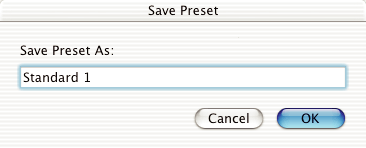
 |
Make sure that the name you entered in step 2 is saved in the Presets pull-down menu.
|
Using your saved settings in the Print dialog
To use your saved settings, select the name of your custom setting from the Presets pull-down menu.
If you change the Media Type or Color settings while your customized setting is selected in the Saved Settings list, your saved setting is not affected by the change. To return to your saved setting, simply reselect it in the list.
You can see how your data will look before actually printing it.
 |
Note: |
 |
|
Preview is a standard feature of Mac OS X.
|
|
To preview your data, follow the steps below.
 |
Make your printer driver settings.
|
 |
Click Preview in the Print dialog. The Preview dialog appears and displays a preview of your data.
|
| 
























 Printer
Printer
 Top
Top

